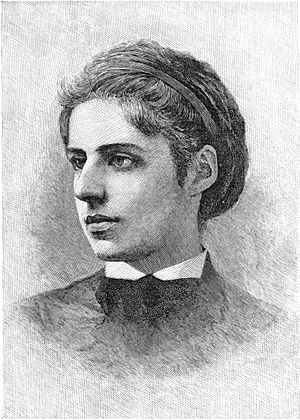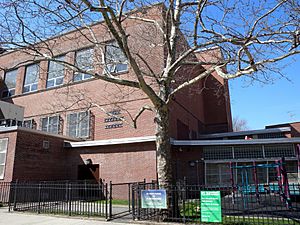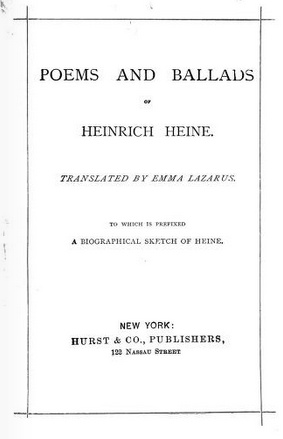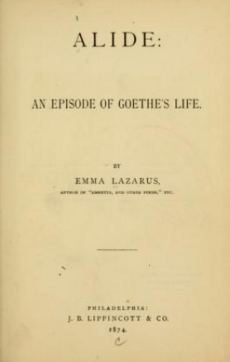Emma Lazarus facts for kids
Quick facts for kids
Emma Lazarus
|
|
|---|---|

Lazarus, c. 1872
|
|
| Born | July 22, 1849 New York City, New York, U.S. |
| Died | November 19, 1887 (aged 38) New York City |
| Resting place | Beth Olam Cemetery in Brooklyn, New York City |
| Occupation | Author, activist |
| Language | English |
| Genre | poetry, prose, translations, novels, plays |
| Subject | Georgism |
| Notable works | "The New Colossus" |
| Relatives | Josephine Lazarus, Benjamin N. Cardozo |
| Signature | |
Emma Lazarus (born July 22, 1849 – died November 19, 1887) was an American writer and activist. She wrote poems, stories, and translated works from other languages. Emma is best known for her famous poem, "The New Colossus". This poem was inspired by the Statue of Liberty and was written in 1883.
The powerful words from her poem are now on a bronze plaque. This plaque was placed on the base of the Statue of Liberty in 1903. The last lines of her poem were even turned into a song. Irving Berlin used them for "Give Me Your Tired, Your Poor" in his 1949 musical Miss Liberty. Another composer, Lee Hoiby, also set parts of the poem to music in 1985. Emma Lazarus also wrote other books and poems, like Poems and Translations and Admetus, and other Poems.
Contents
Early Life and Learning
Emma Lazarus was born in New York City on July 22, 1849. She came from a large and wealthy Sephardic Jewish family. Her father, Moses Lazarus, was a successful merchant and sugar refiner. Her mother was Esther Nathan. Emma was the fourth of seven children.
Her family had deep roots in America. Some of her ancestors came from Portugal and settled in New York long before the American Revolution. They were among the first Jewish people to arrive in New Amsterdam (now New York City). Emma's great-great-grandmother, Grace Seixas Nathan, was also a poet. Emma was also related to Benjamin N. Cardozo, who became a very important judge in the United States.
Emma was taught at home by private teachers. She learned a lot about American and British literature. She also studied several languages, including German, French, and Italian. Emma loved poetry from a young age. She wrote her first poems when she was just eleven years old.
Emma's Writing Career
Emma Lazarus started writing seriously during the American Civil War. Her first collection of poems, Poems and Translations, came out in 1867. She was only 17 years old. Famous writer William Cullen Bryant praised her work. This book included her own poems and translations of works by writers like Friedrich Schiller and Heinrich Heine.
Her next book, Admetus and Other Poems, was published in 1871. Emma dedicated the main poem to her friend Ralph Waldo Emerson. His ideas greatly influenced her writing. Over the next ten years, her poems appeared in popular magazines like Lippincott's Monthly Magazine and Scribner's Monthly.
Recognized Abroad
Emma's writing became known in other countries too. In 1874, she published her first prose work, Alide: An Episode of Goethe's Life. This was a romance story. She also wrote a play called The Spagnoletto in 1876.
In 1881, she published Poems and Ballads of Heinrich Heine. Her translations of Heine's poems are considered some of the best in English. Around this time, she became friends with Rose Hawthorne Lathrop. Emma also wrote articles for magazines, exploring different topics.
Jewish Themes in Her Work
Emma Lazarus became more interested in her Jewish heritage. This happened after she learned about the terrible attacks on Jewish communities in Russia in 1881. These attacks, called pogroms, caused many Jewish people to leave Russia and come to New York.
Her new interest led her to write poems with Jewish themes. These included "The Crowing of the Red Cock" and "The Banner of the Jew". She also wrote a play called The Dance to Death. This play was about the burning of Jews during the Black Death in a German town. Emma also translated works by medieval Hebrew poets.
The New Colossus
The most famous of her poems is "The New Colossus". She wrote it in 1883. Emma donated this poem to an auction. The auction was held to raise money for the pedestal of the Statue of Liberty. This statue is also known as Liberty Enlightening the World.
Her close friend, Rose Hawthorne Lathrop, was so inspired by "The New Colossus" that she started a religious group called the Dominican Sisters of Hawthorne.
Emma traveled to Europe twice, once in 1883 and again from 1885 to 1887. During her travels, she met famous writers and artists. These included William Morris, Henry James, and Robert Browning. Her last book, Poems in Prose, was published in 1887. After she died, her Complete Poems with a Memoir was published in 1888.
Emma's Activism
Emma Lazarus was a friend and admirer of Henry George, an American economist. She strongly believed in his ideas about economic fairness. She became active in the "single tax" movement, which aimed to tax land value. Emma even published a poem in the New York Times named after George's book, Progress and Poverty.
As she learned about the struggles of Jewish immigrants from Russia, Emma became a strong advocate for them. She helped create the Hebrew Technical Institute in New York. This school offered job training to help Jewish immigrants become self-supporting. She also volunteered at the Hebrew Emigrant Aid Society. In 1883, she started the Society for the Improvement and Colonization of East European Jews.
Emma wrote articles for Jewish newspapers. She discussed the challenges faced by Jewish people at the time. She also pushed for Jewish education and supported the idea of an independent Jewish homeland in Palestine. Her collection of poems, Songs of a Semite: The Dance to Death and Other Poems, was published in 1882. It was dedicated to the memory of George Eliot.
Death and Lasting Impact

Emma Lazarus returned to New York City very sick after her second trip to Europe. She passed away two months later, on November 19, 1887. She was likely suffering from Hodgkin's lymphoma, a type of cancer. Emma never married. She was buried in Beth Olam Cemetery in Cypress Hills, Brooklyn.
After her death, a collection of her poems, The Poems of Emma Lazarus, was published in 1889. Her writings and letters are kept in important historical archives.
Emma Lazarus has been honored in many ways.
- In 1985, a stamp featuring the Statue of Liberty and her poem "The New Colossus" was issued by Antigua and Barbuda.
- In 1992, she was recognized as a Women's History Month Honoree.
- In 2008, her home in New York City was included on a map of historic sites for women's rights.
- In 2009, she was added to the National Women's Hall of Fame.
- The Museum of Jewish Heritage had an exhibition about her in 2012.
Her Writing Style and Important Ideas
Emma Lazarus helped shape how the United States sees itself. She also influenced how the country understands the needs of immigrants. Her writings brought attention to immigrants and their need for respect.
A major event that inspired her was the arrival of Russian Jewish immigrants in America. This happened because of harsh laws in Russia in 1882. Emma strongly defended her fellow Jewish people in powerful articles. Before this, her life had not focused much on Jewish themes. Even though her family was Jewish, they had not been very active in Jewish community life.
Meeting the struggling immigrants from Russia led her to study Jewish history, the Hebrew language, and the Torah (Jewish holy texts). While her early poems did not have Jewish themes, her book Songs of a Semite (1882) is considered the first collection of Jewish American poetry.
Selected Works
- Lazarus, Emma (1888). The Poems of Emma Lazarus. Houghton, Mifflin and Company. https://archive.org/details/poemsemmalazaru03lazagoog. "Emma Lazarus."
- "In the Jewish Synagogue at Newport"
- "In Exile"
- "Progress and Poverty"
- "The New Colossus"
- "By the Waters of Babylon"
- "1492"
- "The New Year"
- "The South"
- "Venus of the Louvre"
Images for kids
See also
 In Spanish: Emma Lazarus para niños
In Spanish: Emma Lazarus para niños



